Round-up: 4 retro bass guitars
Semi-hollow thinline basses reviewed, compared
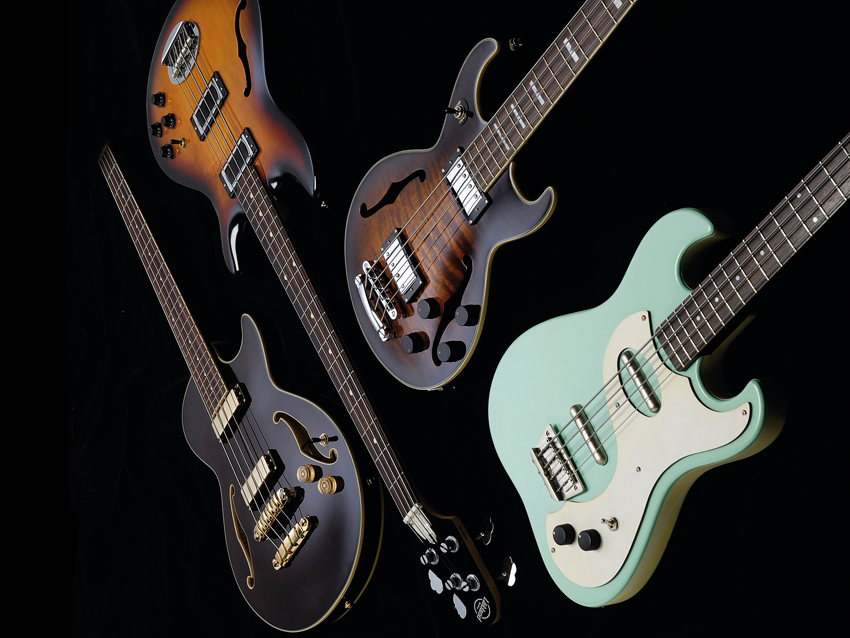
4 retro bass guitars (£279-£1549)
The fifties may have been a decade of optimism and renewed hope for the future, but as far as the newly invented electric bass guitars went, it was almost a no hope situation in the UK.
The trade embargo with America was still in place, so nothing was finding its way to our shores from that direction. Out of necessity, skiffle offered a solution by producing the fabled ‘tea chest’ bass, which was better than nothing… but only just! Gradually European brands began to meet the demand, with Höfner models going mainly to Liverpool docks while Framus found their way to London.
The Höfner Violin bass and the Framus Star bass soon found favour with us Brits and they both featured a thinline, semi-hollow construction. Later, when the USA embargo was lifted and Fender and Gibson instruments flooded over, there were still many players who opted for semi-hollow designs. The Gibson EB-2 and the almost identical Epiphone Rivoli tended to dominate (if you could afford them) but the Höfner Violin experienced a resurgence of interest thanks to Paul McCartney, of course.
Sadly the appeal of the semi gradually declined towards the end of the sixties, yet great models continued to appear and are still with us today. True, they can be hard to find but they offer their own sounds, highly individual feel, very distinctive looks and generally don’t cost that much either.
As with most classes of instrument, today’s semis fall into two main groups: those that follow or emulate past favourites and those that add more than a touch of originality. Either is fine, just as long as they’re well made and in this we find that things are all well up to expectations. Sizes and weights also vary significantly and that may well have an impact on what you decide to try if your fancy is tickled by something from this genre.
The 'different' factor
So what’s the attraction of a semi-hollow, you may ask? Well the depth of sound and the generally lighter weight compared to a solid-bodied bass has a great deal to do with it, but the ‘different’ factor is there too. So if you’re not attracted by the industry giant solid body models (perhaps because so many people own one), these offer a cool-looking alternative.
Who knows, if you get to grips with one it might just become synonymous with you - just like Macca and his Höfner…
First up: Danelectro ’63 Long Scale Bass price and spec
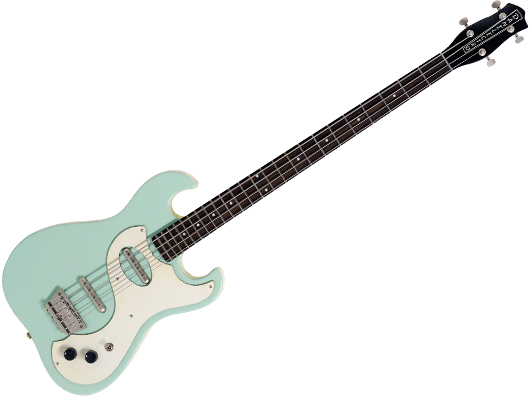
Danelectro '63 Long Scale Bass price and spec
Spec
Price: £279
Origin: China
Body: Masonite top and back, plywood frame
Neck: Maple bolt on, 864mm (34-inch) scale, 41.75mm at nut
Fingerboard: 24 medium frets, rosewood ’board, pearl dot inlays
Hardware: Zero gloss nickel (satin chrome) bridge; adjustable saddles; high ratio sealed gear tuners
Electrics: Two lipstick-style Alnico single-coils; volume and tone controls; three-way toggle selector
Options: ’63 Short Scale (£279)
Left-handers: No
Finishes: Aqua (as reviewed), red burst, black
Next: Danelectro ’63 Long Scale Bass build and features
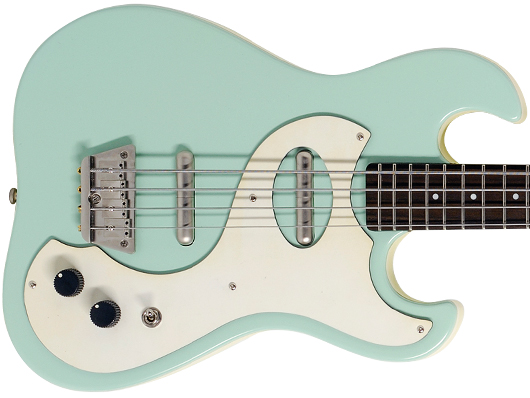
Danelectro '63 Long Scale Bass build and features
Build and features
No we haven’t gone mad, for although the Dano has the visual presentation of a solid body, it’s actually constructed of a top and back fitted to a skeletal frame. This way you get the lighter weight of a semi-hollow design and good sustain, in a compact instrument.
The name, if not the model, has been around since the early days of rock’n’roll, so is rightfully well-established and respected. In reality we could have chosen any model from Dano’s bass catalogue, as they all adopt the same construction, but we decided on the ’63 as it’s still relatively new and this model never made it to Britain when it was first introduced.
As always, the hardware looks inadequate, with a simple bridge, high ratio guitar-sized tuners and radio-style knobs. But put it all together and you have an iconic design that immediately throws you back in time. Amazingly comfortable to play and with a very well presented neck profile, this ’63 is a positive steal at under £300.
Next: Danelectro ’63 Long Scale Bass sounds, pros and cons
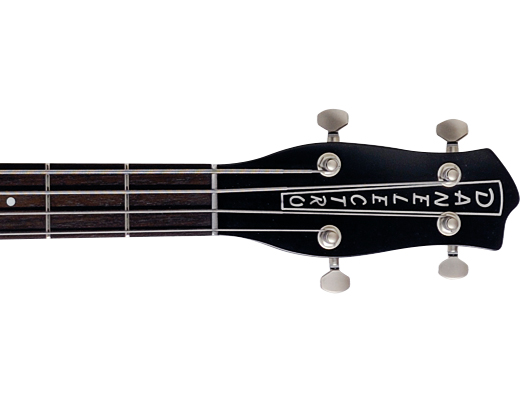
Danelectro '63 Long Scale Bass sounds, pros and cons
Sounds
Loud and sometimes brash, any Danelectro bass refuses to take a back seat when it comes to sound, so expect that usual brightness and edgy quality that makes them great in the studio and for live work too.
Although initially designed as a cheap ‘catalogue’ guitar, the sound is in a spot of its own and, whether by accident or design, it has a sonorous and unique voice that can be spotted a mile away. It’s a little lacking in low-end compared with others here, but the twangy appeal remains undeniable.
With only a single volume and tone control for adjusting both pickups, and a three-way selector switch to engage the units, onboard sound mixing is obviously limited. But that’s the sound of a Danelectro bass and it remains impressive, even if less expansive than many twin-pickup models.
If you choose one of these it’s precisely the sound and the feel that really attracts, and it delivers this by the bucketload.
Pros: Iconic looks; distinctive voice; light weight.
Cons: Unique tone means less versatility.
4 out of 5
Verdict: Quirky kitsch appeal by the bucketload and plenty of twang and punch. Oomph lies elsewhere.
Next: Ibanez AGB200 Artcore Bass price and spec
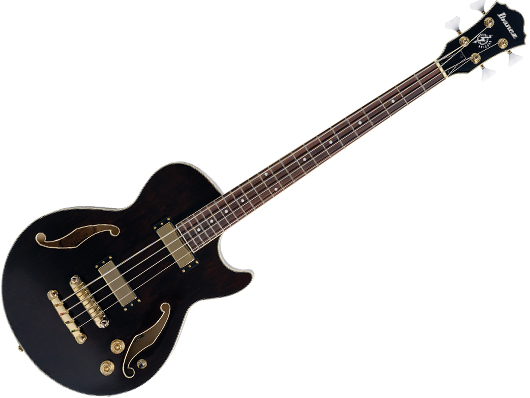
Ibanez AGB200 Artcore Bass price and spec
Spec
Price: £389
Origin: China
Body: Fully bound, maple sides, back and top
Neck: Three-piece mahogany/maple, glued-in, 770mm (30.3-inch) scale, 42mm at nut
Fingerboard: 22 medium frets; bound rosewood fretboard; pearl dot inlays
Hardware: Gold plated Gibraltar IIIB bridge; stop bar Quik Change IIIB tailpiece; sealed gear tuners with white pearl blades
Electrics: IBZ ACHB-2N pickup at neck; IBZ ACHB-2B pickup at bridge; volume and tone controls; three-way toggle switch
Options: AFB200 Artcore Bass (£389)
Left-handers: No
Finishes: Transparent brown only at present, but ivory due later this year at same price
Next: Ibanez AGB200 Artcore Bass build and features
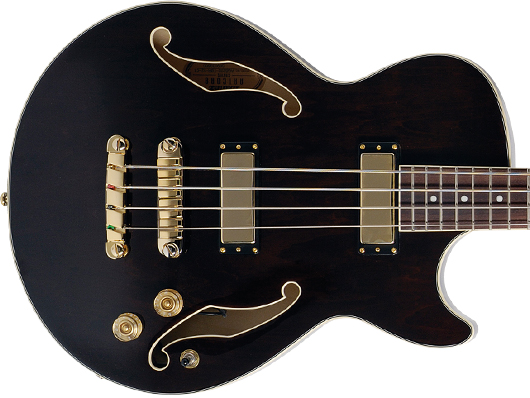
Ibanez AGB200 Artcore Bass build and features
Build and features
This is a particularly well-balanced design, thanks to its short scale length and the resulting proportions. Adopting the persona of a Les Paul-style bass, it offers a far more conventional look with two large f-holes, gold-plated hardware and a deep and luxurious transparent brown finish, which reminds us of the Gretsch Country Gentleman.
Fully-bound all round (including the f-holes) this also benefits from an arched back and front and a classic slimline feel about it - it’s genuinely slender from front to back.
The AGB200 has a separate bridge and tailpiece and these individual units are chunky in appearance, which suits the instrument well. The same can be said for the keener-sized pickups, which are much more visually appropriate for a shorter-scaled instrument than regular units.
The choice of control knobs is also spot on, carrying on the gold-on-brown theme. We also like the white pearloid buttons on the tuners.
Next: Ibanez AGB200 Artcore Bass sounds, pros and cons
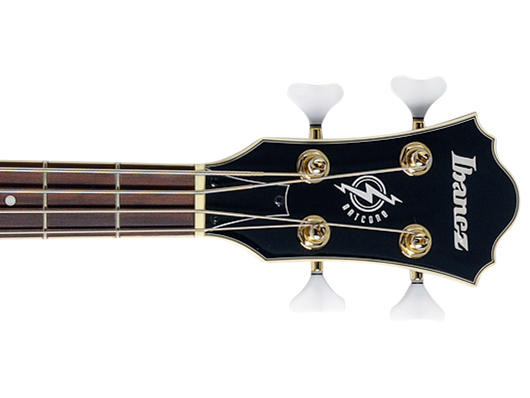
Ibanez AGB200 Artcore Bass sounds, pros and cons
Sounds
As with the Danelectro, the single volume and tone control with a three-way pickup selector means this bass isn’t able to realise its full twin-pickup potential, as you can’t alter the way the pickups blend. But while this may remove that desirable adjustable sweet spot facility, it actually unleashes some real no-nonsense delivery.
Individually, or with both pickups working at the same time, this has a surprisingly solid and fully rounded sound with great note definition.
Having a set-neck construction increases the sustaining properties of the bass and the shorter scale length ensures a tight clean delivery. Add that to the tough tone and this becomes a surprisingly gutsy little beast that seems ready to rock at every opportunity. Of course there’s enough tonal variation to suit most genres, but it really responds well to being driven hard.
It’s a bit of a wolf in sheep’s clothing this one!
Pros: Classic-style design; super finish; manly sounds.
Cons: Shame there’s no case or gig bag.
4.5 out of 5
Verdict: This Artcore bass is well priced, nicely made and sounds good - you should try one.
Next: Hutchins Prince II Bass price and spec
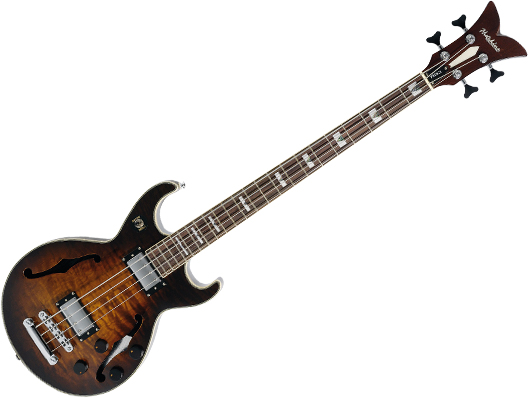
Hutchins Prince II Bass price and spec
Spec
Price: £450 (inc case)
Origin: China
Body: Mahogany back and sides, quilted maple bound top
Neck: Unspecified, glued in, 864mm (34-inch) scale, 42.5mm at nut
Fingerboard: 22 medium frets; bound rosewood ’board; block inlays of mother of pearl with triangular abalone inserts
Hardware: Separate bridge and stop bar tailpiece; Grover sealed-gear tuners
Electrics: Two chrome Entwistle humbucker pickups; two volume; two tone controls; three-way toggle switch
Options: Memphis Bass (£499)
Left-handers: No
Finishes: Brownburst (as reviewed)
Next: Hutchins Prince II Bass build and features
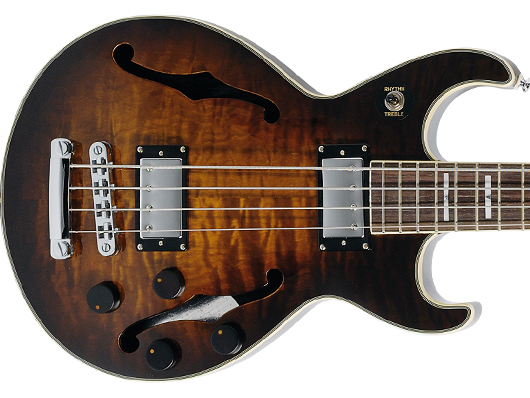
Hutchins Prince II Bass build and features
Build and features
Hutchins instruments are slowly making their mark on the British guitar market thanks to good design, good build quality, distinctive tonal attributes and competitive pricing. Although most of their basses take on the persona of classic instruments, the Prince II offers a more original look.
With its full-frontal binding on neck and body, double cutaway and nipped-in waist, it presents a stylish, compact appearance, enhanced by a beautiful quilted (veneer) arched maple top. The back is flat and the combination of modest upper cutaway, overlarge headstock and full-scale proportions does mean that the unsupported balance isn’t brilliant, but your right arm rested on the body solves this.
The use of wooden knobs on the four controls makes sense, as they all but disappear at a distance, and the black buttons of the Grover tuners also serve the looks well. The neck proportions are generous for a semi-acoustic bass and give this instrument the sense that it means serious business.
Next: Hutchins Prince II Bass sounds, pros and cons
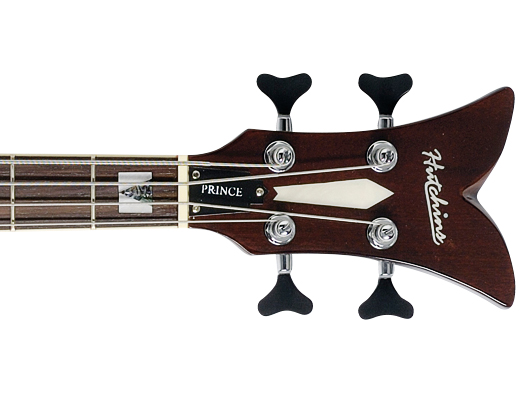
Hutchins Prince II Bass sounds, pros and cons
Sounds
With pickups and circuitry commonly associated with Gibson, it’s easy for more experienced players to imagine just how this bass sounds - but actually you’d be wrong. This pair of Entwistle humbuckers are well named, possessing a bright yet surprisingly warm quality.
With both pickups on, the results are truly excellent. The pickups are well matched in output, too, with no discernible loss of volume when engaging both units.
Unusually, the controls for the neck pickup are positioned north of the f-hole leaving the bridge pickup controls to the south. Both offer a decent variation in tone but nothing too extreme, so all the sounds produced here retain constantly good body and are completely usable.
But it’s the combination of both pickups that really brings a smile to the face. These blended sounds are sumptuous, full of charm, fatness and character.
Pros: Body size and shape; sound blending abilities; well-padded case.
Cons: The oversized headstock design.
4 out of 5
Verdict: A uniquely styled thinline bass with a super voice.
Next: Lakland Skyline Hollowbody Bass price and spec
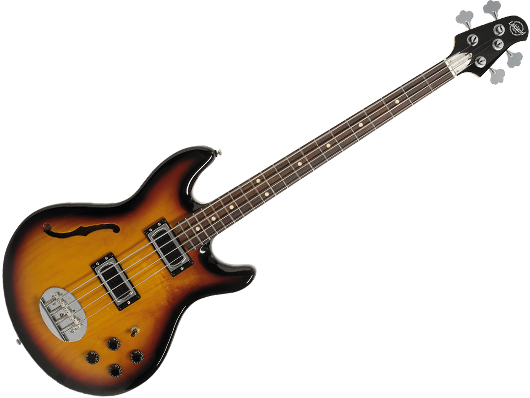
Lakland Skyline Hollowbody Bass price and spec
Spec
Price: £1,549
Origin: Indonesia
Body: Carved mahogany back and sides, carved maple top
Neck: Flat-sawn maple, bolt-on, 864mm (34-inch) scale, 41.25mm at nut
Fingerboard: 20 medium frets, rosewood ’board, dot inlays
Hardware: Chrome Lakland bridge; Hipshot licensed Ultralite tuners
Electrics: CS series humbucking Chi-Sonic pickups; volume/volumetone/ tone (passive); three-way toggle
Options: Lined fretless with side dots at same price; USA-built version (£3,267), USA Deluxe model (£3,667)
Left-handers: No, but manufacturers suggest “the Hollowbody’s symmetrical body means it can be restrung and played left handed, although the controls will then be at the ‘top’ of the bass”
Finishes: Three-Tone Translucent (Sunburst) only
Next: Lakland Skyline Hollowbody Bass build and features
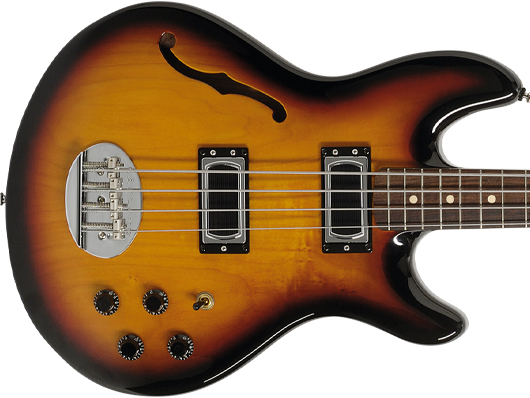
Lakland Skyline Hollowbody Bass build and features
Build and features
Lakland enlisted designer Michael Tobias for the US version and most of that spec is included in this Skyline model, so it’s no wonder that it looks and performs so well. Each bass is built in Asia, then shipped to Chicago and given a Plek set-up before distribution.
Further savings come from the woods, tuners, truss rod and just the one finish. It may be a compromise but you still get a pro-standard bass. With its carved top and back, surface-mounted controls, single f-hole, lovely curved body edges and unadorned fingerboard, the Skyline offers a degree of understatement and as a result tends to draw the eye.
Standard Lakland features such as the raised tail bridge, neat black fronted headstock and elephant ear tuners are embellished by the new CS series Chi-Sonic pickups and a curious pearloid truss rod cover. For something so new, the visual result is both traditional and desirable.
Next: Lakland Skyline Hollowbody Bass sounds, pros and cons
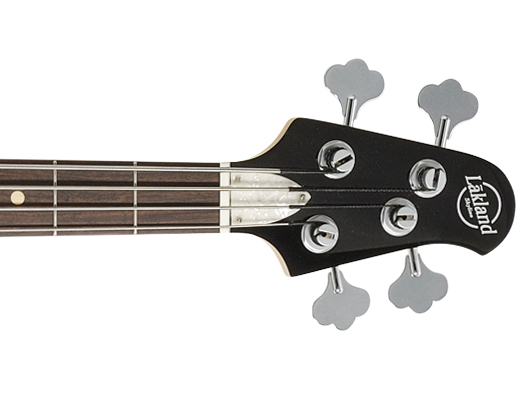
Lakland Skyline Hollowbody Bass sounds, pros and cons
Sounds
Our review model is fitted with flatwound strings, so obviously it possesses a different feel to the rest but, importantly, it also presents a different slant on the sounds. It’s full of body, very warm and robust in tonal content. And with volume and tone controls for each pickup, along with a three-way selector switch, it has the power to offer the ultimate in twin-unit mixing.
The sweet spots are certainly there and, although they seem not so well pronounced as on the Hutchins, we feel that’s mainly down to the choice of strings and the pickup position also means they’re operating somewhat closer together. Yet these Chi-Sonic units are very impressive with a more traditional sound than the Prince II.
They also provide confident delivery, clear notation, great bottom-end for warmth over the entire range and a smooth edge to the upper frequencies. All in all this a very versatile machine that upholds its brand’s fine reputation.
Pros: Modern-retro; great sound; pro feel.
Cons: Flatwound strings.
4.5 out of 5
Verdict: Lakland is still a new name to many UK players. But while it costs a lot more than others, it’s definitely the pro choice.
Next: The verdict - which bass is best?

The verdict - which bass is best?
Verdict
As our examples prove, the thinline semi bass market is still very much alive and kicking, in spite of the fact that finding them can be difficult. With the exception of the Danelectro they offer a very different playing experience to a solid body, and if lighter weight is an important consideration then all of these score highly on that count.
They’re also very different in style, but will all certainly add some air to your tone. The Danelectro might be basic but it’s highly affordable and has its own unique style along with bright, characterful tones. Ibanez’s Artcore range is far away from the brand’s modern metal tag but this AGB200 proves you shouldn’t pigeonhole them. Classic in style with solid sounds, it’s an endearing bass.
The Hutchins is the most unusual piece here with a modern style that produces some very good sounds. The Lakland, however, is in a class of its own, with a much higher price but a very professional vibe - ideal for any professional or semi-pro musician who needs another voice.
Ultimately, these are all eminently practical and desirable instruments too, producing a fine variety of tones, and all perform extremely well in action. If you fancy a change in style, you could do a lot worse than trying out a thinline semi.
Liked this? Now read: 10 best bass guitars under £300
Connect with MusicRadar: via Twitter, Facebook and YouTube
Get MusicRadar straight to your inbox: Sign up for the free weekly newsletter









